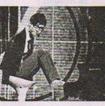用括号内所给词的适当形式填空(每空不限一词)。1. My hobby is reading comic books. What about ______ (you)? 2. Three ______ (five) of the students in our class -九年级英语
a map of the world
the story of a hero
the windows of the room
the title of the film
2.用于名词化的词。例如:
the sticks of the blind 盲人的拐杖
3.修饰词较多时也可用of所有格。例如:
the very long and graceful tail of the black cat 黑猫的又长又美的尾巴
4.表示有生命的东西的名词,有时也可以用of所有格。例如:
the children of the family 那家的孩子们
某些of所有格和's所有格可以互换。
the son of a poor peasant=a poor peasant's son 一个贫农的儿子
但有时含义却不相同,请比较下面的例子:
an old woman's story(一个老妇人讲自己的身世)
the story of an old woman(别人讲一个老妇人的身世)
三、's所有格和of所有格可以表示下面的关系:
1.所有关系
the students'reading room 学生阅览室
2.主谓关系
the arrival of the train 火车的到达
3.动宾关系
the search of knowledge 知识的探究
4.同位关系
the name of Kate 凯特这个名字
四、双重所有格及其用法
's所有格和of所有格两种所有格形式结合在一起,构成"of+所有格"形式,即双重的所有格。
它通常表示部分观念,即全体中的一部分,在意义上与"one of..."相似,它主要修饰of短语之前的那个名词。
此外,双重所有格与指示代词连用时,常带有感情色彩,如赞赏、不满、厌恶等。它的主要形式如下:
1.名词+of+名词性物主代词。例如:
a good friend of mine 我的一个好朋友
an interesting story of his 他的有趣的经历
2.名词+of+'s所有格。例如:
He is a friend of my sister's.(=one of my sister's friends)他是我姐姐的一个朋友。
Look at that long nose of Jack's.看杰克的那个长鼻子。(感情色彩)
试比较:
a picture of Xiao Zhang 小张(本人)的照片
a picture of Xiao Zhang's 小张(具有的照片中)的一张照片
此外,不定冠词、数词、某些不定代词(some,any,many,no,few等)以及which等限定词,
一般不与形容词性物主代词或's所有格等一起放在名词前修饰名词,而采用of所有格或双重所有格形式。例如:
most of the students 学生中的大多数
three of them 他们中的三个人
I have read some books of his.我读过他的一些书。
Which book of Qiong Yao's have you read?你读过琼瑶的哪一本书?
考点名称:序数词
- 序数词:
是数词的一种,主要在英语语法中讲到,在汉语中表示为“第几”。如:first, second, third, fourth 序数词的读法与写法:
序数词写法:
1 first ;2 second ; 3 third ;4 fourth ; 5 fifth ;
6 sixth ;7 seventh; 8 eighth;9 ninth ;10 tenth ;
11 eleventh ;12 twelfth ;13; thirteenth ;14 fourteenth;15 fifteenth
16 sixteenth ;17 seventeenth ;18 eighteenth;19 nineteenth;
20 twentieth ;30 thirtieth ;40 fortieth ;50 fiftieth ;60 sixtieth ;70 seventieth;80 eightieth ; 90 ninetieth多位序词:
由基数词的形式变结尾部分为序数词形式来表示。
one hundred and twenty-first 第一百二十一
one thousand three hundred and twentieth 第一千三百二十
two hundred and fifty-second 第二百五十二缩写:
有时,序数词可以用缩写形式来表示。主要缩写形式有:
first——1st ;second——2nd ;third——3rd; fourth——4th ;sixth——6th ;twentieth——20th;twenty-third——23rd
其中lst,2nd,3rd为特殊形式,其它的都是阿拉伯数字后加上th。序数词前不加the的情况:
在英语中,使用序数词时前面要加定冠词 the,但是,在下面的情况下则不加 the:
1.当序数词前有形容词性物主代词或名词所有格修饰时,序数词前不用 the。
Mother was my first teacher in my life.妈妈是我生命中的第一个老师。
Tom is Lily's third boyfriend. 汤姆是莉莉的第三个男朋友。
2.当表达分数时,序数词前不用 the。
One fifth of the students here are from the country. 这儿1/5的学生来自农村。
Three fourths of the students here are from the country. 这儿的3/4的学生来自农村。
3.当表达“又一,再一”时,序数词前不用 the,但可加不定冠词。
Please give me a second chance. 请再给我一次机会。
The poor woman had a third baby. 那个可怜的妇女又生了第三个宝宝。
4.当表达“年月日”时,尤其在朗读时,序数词前要加 the。
He was born on June 6th, 1974. 他出生在1974年6月6日。
5.当序数词在句中作状语时,序数词前不用 the。
Who got there second? 谁第二个到那儿的?
I finished the work first. 我最先完成那项工作。
6. 当表达考试(比赛等)中获得的名次时,序数词前不用 the。
She stands first in her class. 她在班上成绩排名第一。基数词变序数词的口诀:
基变序,有规律,词尾加上-th。
一,二,三,特殊记,词尾字母t,d,d。
八去t,九除e,ve要用f替,ty将y变成i,th前面有个e。
若是碰到几十几,前用基来后用序。
整十基数变序数,先把ty变成tie,要是遇上两位数,十位基数,个位序,th最后加上去。
或者一,二,三变字体;th从4上起;8加h,9减e;用f 代ve;ty变为tie。序数词的语法功能及用法:
序数词在句中可作主语、宾语、定语和表语。
The second is what I really need. 第二个是我真正需要的。(作主语)
He choose the second. 他挑选了第二个。(作宾语)
We are to carry out the first plan. 我们将执行第一个计划。(作定语)
She is the second in our class.在我们班她是第二名。(作表语)
注:序数词在使用时,通常前面要加定冠词 the;但是如果序数词前出现不定冠词a或an时,则表示“再—”,“又—”。
We'll go over it a second time. 我们得再念第二遍。
We've tried it three times.Must we try it a fourth time? 我们已经试过三遍了,还必须试一次(第四次)吗?
表示顺序的序数词
只需将基数词放在它所修饰的名词之后即可,不需要添加定冠词。
the first lesson——Lesson One the fifth page——Page 5(five)
the twenty-first room——Room 21(twenty-one)
考点名称:形容词的比较级,形容词的最高级
- 形容词的比较级:
当两种物体之间相互比较时,我们要用形容词或副词的比较级;
当相互比较的物体是三个或三个以上时,我们就要用形容词或副词的最高级。 形容词的比较级和最高级的特殊变化规则:
一、少数单音节词前面加 more-, most- 构成比较级和最高级
tired ---- more tired , most tired
fond ----- more fond , most fond
glad ----- more glad , most glad
bored ---- more bored , most bored
pleased---- more pleased , most pleased二、不规则变化
good /well------- better ,best
bad/badly/ill------ worse , worst
many/much-------more , most
little ------ less , least
far ---- farther, farthes / firther , furthest
old ---- older , oldest (GA)
---- older , oldest / elder , eldest (GB)三、下列形容词和副词的比较级和最高级有两种形式
cruel----- crueler, cruelest /more cruel , most cruel
strict---- stricter , strictest /more strict , most strict
often----- oftener , oftenest / more often , most often
friendly------ friendlier , friendliest / more friendly , most friendly
clever----- cleverer, cleverest / more clever , most clever四、下列形容词和副词没有比较级和最高(即表示”最高程度”或”绝对状态”的形容词和副词没有比较级和最高级)
empty , wrong , perfect , unique , extreme , excellent , favourite (GB)/ favorite (GA) , true , right , correct , extremely ...- 形容词的比较级和最高级用法:
形容词比较等级用法:
1.没有比较对象时,用原级。
I have a new computer.
2.两者比较,程度相同。
A+系动词+as+adj.+as+B.
Our school is as beautiful as theirs.
3.两者比较,程度不同。
A+系动词+not as+adj.+as+B.
The weather here is not as hot as that in the south.
4.A比B更…
The earth is bigger than the moon.
5.比较级前可以用much,even,still,far,a lot,a little,a bit,any等修饰。
- 最新内容
- 相关内容
- 网友推荐
- 图文推荐
| [家长教育] 孩子为什么会和父母感情疏离? (2019-07-14) |
| [教师分享] 给远方姐姐的一封信 (2018-11-07) |
| [教师分享] 伸缩门 (2018-11-07) |
| [教师分享] 回家乡 (2018-11-07) |
| [教师分享] 是风味也是人间 (2018-11-07) |
| [教师分享] 一句格言的启示 (2018-11-07) |
| [教师分享] 无规矩不成方圆 (2018-11-07) |
| [教师分享] 第十届全国教育名家论坛有感(二) (2018-11-07) |
| [教师分享] 贪玩的小狗 (2018-11-07) |
| [教师分享] 未命名文章 (2018-11-07) |


![—______ is Jenny.—I’m Gina. Nice to meet you.[ ]A. I’mB. His nameC. I’mD. My name-七年级英语](http://www.00-edu.com/d/file/ks/4/2/wuzhudaici/2019-11-29/small48b153aa794daeb090c5d2505d5cbbac1575042450.png)



